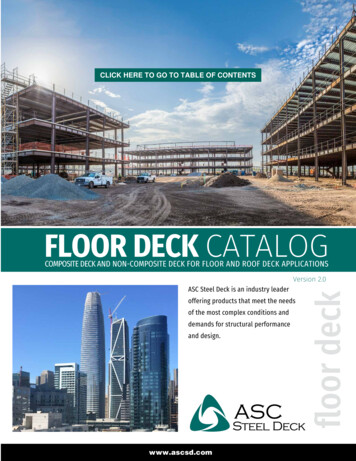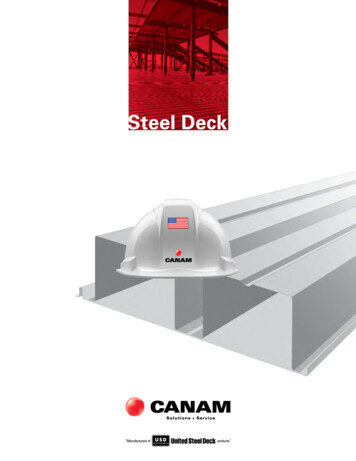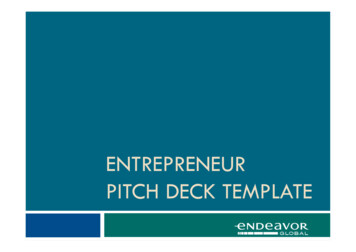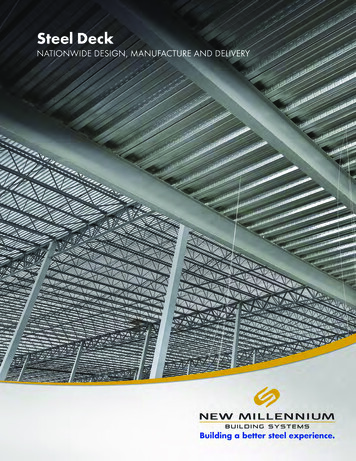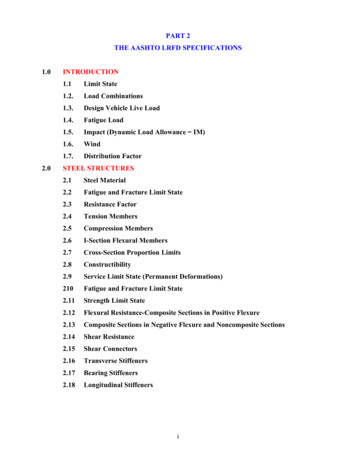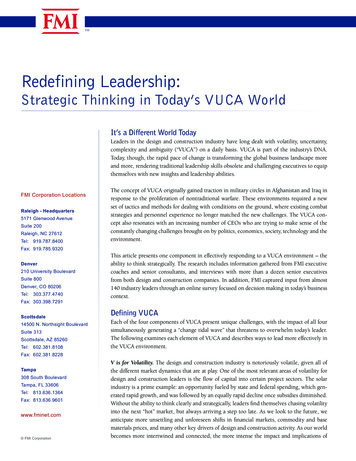
Transcription
TMRedefining Leadership:Strategic Thinking in Today’s VUCA WorldIt’s a Different World TodayLeaders in the design and construction industry have long dealt with volatility, uncertainty,complexity and ambiguity (“VUCA”) on a daily basis. VUCA is part of the industry’s DNA.Today, though, the rapid pace of change is transforming the global business landscape moreand more, rendering traditional leadership skills obsolete and challenging executives to equipthemselves with new insights and leadership abilities.FMI Corporation LocationsRaleigh - Headquarters5171 Glenwood AvenueSuite 200Raleigh, NC 27612Tel: 919.787.8400The concept of VUCA originally gained traction in military circles in Afghanistan and Iraq inresponse to the proliferation of nontraditional warfare. These environments required a newset of tactics and methods for dealing with conditions on the ground, where existing combatstrategies and personnel experience no longer matched the new challenges. The VUCA concept also resonates with an increasing number of CEOs who are trying to make sense of theconstantly changing challenges brought on by politics, economics, society, technology and theenvironment.Fax: 919.785.9320Denver210 University BoulevardSuite 800Denver, CO 80206Tel: 303.377.4740Fax: 303.398.7291Scottsdale14500 N. Northsight BoulevardSuite 313Scottsdale, AZ 85260Tel: 602.381.8108This article presents one component in effectively responding to a VUCA environment – theability to think strategically. The research includes information gathered from FMI executivecoaches and senior consultants, and interviews with more than a dozen senior executivesfrom both design and construction companies. In addition, FMI captured input from almost140 industry leaders through an online survey focused on decision making in today’s businesscontext.Defining VUCAEach of the four components of VUCA present unique challenges, with the impact of all foursimultaneously generating a “change tidal wave” that threatens to overwhelm today’s leader.The following examines each element of VUCA and describes ways to lead more effectively inthe VUCA environment.Fax: 602.381.8228Tampa308 South BoulevardTampa, FL 33606Tel: 813.636.1364Fax: 813.636.9601www.fminet.com FMI CorporationV is for Volatility. The design and construction industry is notoriously volatile, given all ofthe different market dynamics that are at play. One of the most relevant areas of volatility fordesign and construction leaders is the flow of capital into certain project sectors. The solarindustry is a prime example: an opportunity fueled by state and federal spending, which generated rapid growth, and was followed by an equally rapid decline once subsidies diminished.Without the ability to think clearly and strategically, leaders find themselves chasing volatilityinto the next “hot” market, but always arriving a step too late. As we look to the future, weanticipate more unsettling and unforeseen shifts in financial markets, commodity and basematerials prices, and many other key drivers of design and construction activity. As our worldbecomes more intertwined and connected, the more intense the impact and implications of
2TM“We are in the mostvolatile times inconstruction that I havevolatility will be on our businesses. Key to preparing for volatility is anticipating where thecritical shifts will occur, predicting how they might affect the industry (and the company specifically) and testing various scenarios. Equally important in responding to volatility is knowing what NOT to do, and avoiding impulsive and uncoordinated responses.seen in my entire career.That said, we are not in astate of panic and we arenot allowing ourselves tomake decisions that aren’trational. That could be lifethreatening to a company.”Robert W. Bacon, CEO,Kirlin Group, LLCU is for Uncertainty. The modern leader faces uncertainty at an unprecedented level. Oneneed only look to the events of the debt-ceiling debate less than one year ago for a primeexample, with leaders facing the scenario of Congress refusing to raise the U.S. debt ceiling.Consider the case of an engineering and construction firm working in transportation markets trying to plan and strategize when federal, state and local entities are all saying differentthings. In addition, one need not look far to find an expert predicting a sustained recoveryor an equally pedigreed expert threatening the dire consequences of a fallback into recession.Rushing to comprehend the uncertainty is also dangerous. Some of the symptoms of excessiveuncertainty include acting with more confidence, when we are actually less certain than everor increasingly, chasing immediate and short-term opportunities.Our mental models and paradigms for assessing threats and challenges are often too simplisticand inadequate to protect us against the uncertainty inherent in today’s VUCA environment.Using mental models, we compare the new, unexpected challenge to past hurdles, assumingthat those experiences will help us push through the new obstacles. Comments like, “Themarket will go back to what it used to be – it’s just another cycle,” are very emblematic of ourindustry mindset. Unfortunately, relying on our deeply held beliefs can sometimes result inflawed assumptions and force us to assume that the solutions that worked in the past will alsowork in this new VUCA world.C is for Complexity. Quantitative easing, credit default swaps, collateralized debt obligations,integrated project delivery (IPD), federal health care and building information modeling (BIM)are just a few examples of the many external factors increasing the complexity of today’s business environment. Any one of these factors is a study in complexity, with many interveningfactors, various inputs and outputs, and deep, far-ranging social, economic and technologicalimplications. Leaders operating in today’s world must be able to make the “if/then” connections among these factors and go beyond viewing challenges and opportunities as collective;rather, they must see them as interactive.Consider the example of contractors who have tried to move their businesses from privatemarkets to chase federal markets, learning painful lessons in managing the complexity of newrequirements and processes. Such complexities frequently result in confusion and increasedattempts to make sense of the increasingly sophisticated business environment.A is for Ambiguity. As we look around our industry, macro-and microeconomic trends continuously influence and shape our everyday business environment, requiring leaders to approachboth opportunities and challenges from multiple perspectives without falling subject to theirown viewpoint. There is no shortage of data to process, interpret and analyze. With a fewclicks of a mouse, a leader can collect information on unemployment rates, consumer confidence, GDP growth and public market performance. However, without the clarity of strategicthinking, this information is ambiguous at best and can mislead us or only confirm what we
3TMwant to see. For example, consider the rapid rise of key public market indices such as the DowJones Industrial Average and the S&P 500. Simply using these as indicators of a recoveringeconomy leads to dangerous assumptions for leaders in the design and construction industrywho operate in fractured, local and regional markets. The typical human response to ambiguity is to look for incremental problems to solve, but failing to grasp the larger root issues.Success FactorsThere are no easy answers or quick fixes to think more strategically in the face of a VUCAworld. Following are some key success factors – each of which comes with a warning thatthey are “simple, not easy,” meaning that they sound simple but fall apart without rigorousdiscipline and dedicated attention: Don’t lose sight of the big picture by trying to solve all challenges at hand. Beready to flex and respond to rapidly unfolding scenarios while also retaining aclear vision over which judgments should be made. Make sure your employeesunderstand the company’s vision. This will equip them to handle unpredictableand/or violent shifts in your business environment. Set up incremental milestones and develop consistent messaging and cleardirection, particularly when goals and priorities keep shifting. The path itself maynot be clear, but having tangible milestones in place – and achieving them – willhelp assure that the organization is moving in the right direction. Small successesboost morale and are also great motivators for employees. Carve out open space on your calendar to think on a regular basis, and don’tlet immediate needs usurp this important planning time. Many construction leaders seem to embody the admonition, “Don’t just sit there, DO something!” whensometimes the best advice may be, “Don’t just do something, sit there and think”. Uncertain times bring opportunities for bold moves. Find ways to challengethe appropriateness of your company’s mental models, both individually and collectively. Develop processes and concepts to test new ideas and challenge existingones. Don’t be paralyzed out of fear of making the wrong move. Always stay opento new opportunities without losing sight of the longer-term goals. Encourage networks rather than hierarchies. Develop interdisciplinary, collaborative teams and avoid “silo-like” problem-solving approaches. Ensure thatemployees across the company communicate openly with each other. Develop independent thinkers. Employees who can think for themselves andmake the right decisions in the right moments will help your firm effectivelytackle new, complex projects. Be deliberate with your training and developmentcampaigns. Focus on how the company can improve in the future, rather than lookingto the past. The past is not necessarily an indicator of the future; moreover, it ishighly unlikely that things will return to the way they used to be. Place value oninnovative, temporary solutions that perform well in today’s unpredictable climate, and don’t rely too heavily on solutions that worked in the past.
4TMFigure 1. Elements of Strategic ThinkingThe VUCA environment drives many behaviors that are exactly opposite of the most-effectiveresponse. To avoid impulsive, uncoordinated and ultimately ineffective responses to the increasingly challenging market, today’s leaders must develop new strategic-thinking mindsets.FMI’s experience working with hundreds of senior design and construction leaders underscores a strong belief that strategic thinking is like many other abilities, such as managingprojects or learning a new language. That is, strategic thinking can be taught and developedover time through intentional practice, discipline and reflection. However, just like in athletics, some are blessed with exceptional natural ability, while others are not.Elements of Strategic ThinkingSource: FMI’s Center for Strategic LeadershipThe Strategic Thinking Model created by FMI’s Center for Strategic Leadership illustrates thenecessary elements for developing strategic thinking skills (Figure 1). At the center of themodel is organizational vision, which provides direction for strategic thinking. This allowsleaders to match their thinking and decision making with the organizational strategic initiatives, and often results in long-term success.The outer circle of Figure 1 shows eight different elements for strategic thinking. The rightside of the model includes Mental Flexibility, Intellectual Curiosity, Creativity and Intuition.These skills are internal traits that help with strategic thinking. Some people feel that theseskills are innate natural abilities, but psychological research shows that these skills can be developed just like any other skill. The left side of the model includes Analysis, Systems Thinking, Information Gathering and Decision Making. The skills on the right are centered moreon insight and intuition, and the hard skills are built more on facts, logic and reasoning. Mostleaders are stronger in one side to the detriment of the other, just like a weight lifter who onlyexercises one part of his body.A quick way to self-evaluate is to think about one’s own decision-making process, asking questions like “Do you tend to base your decisions using aptitudes from the right-side or the leftside?” While some of these elements may come naturally to individuals, others may requiredevelopment and training. These aptitudes cannot be developed overnight. Honing each arearequires focus, time and energy from leaders who want to reach their peak potential.So why is it important that today’s design and construction leadership teams — and moreto the point, those of tomorrow — think strategically about the world around them? Moreimportantly, what can be done to develop this capacity? Experiences over the last decade suggest that operating environments will become increasingly volatile, uncertain, complex andambiguous in the years ahead. The future will be defined by VUCA.Strategic Thinking Versus Strategic PlanningMany design and construction companies have faced, or will face, a decisive inflection pointthat will sort them into two main groups: Those that pine for the past by reacting to a rapidlychanging environment and those that anticipate the future by capturing opportunities. In fact,the capacity of leaders to think strategically is one of the greatest differentiators in the newreality of our current economy.
5TMStrategic thinking is often misconstrued as strategic planning. Though the two are similar,there are distinct differences between them. When conducted without hard data and unflinching analysis, strategic planning involves very little “true” strategic thinking. In fact, itcan diminish into a predictable and routine exercise conducted every few years, with decisionmakers taking an already agreed upon strategic direction and deciding how the organizationshould be reconfigured to align with that direction. The result is some form of extrapolationof the present and the past, with little consideration given to reinventing the future. This cancreate a “comfort zone” for the company instead of forcing it to face the reality of an uncertainfuture.Strategic thinking goes beyond the creative process of understanding and adapting to a changing environment. It is a different way of thinking about the impact of markets, trends andother external factors on your organization, including the way you, as a leader, react to thosechanges. It also encompasses a different perspective and approach to dealing with the currentand future environments we are all operating in – as individuals and organizational leaders.Jake Appelman, director of FMI’s Executive Coaching Practice, adds, “Many of the leaderswe work with are dealing with the erosion of their traditional competitive advantages. Theycan no longer count on capturing their historical market share or avoiding competition fromvertically integrated mega-firms. Many are realizing that one source of enduring competitiveadvantage is their ability to read their environment clearly, make sense of it and respond – tothink strategically.”Strategic planning and thinking are essential components in great organizations and neither issufficient without the other. In fact, creative, groundbreaking strategies emerging from strategic thinking still need to be operationalized through convergent and analytical thought (strategic planning). The great challenge organizations face is capturing the best of both.Five Successful Tactics of Strategic ThinkersFMI spoke with executive coaches, senior consultants and more than a dozen executives fromdesign and construction companies to find out how they were adjusting to the new VUCAworld. The following section summarizes five key areas that strategic thinkers are focusing onin today’s uncertain design and construction environment. These areas are also displayed inrelationship to FMI’s strategic thinking model (see graphic inserts), which covers all the strategic thinking tactics described below.1. Be Aware and AnticipateMore than ever, company leaders need a deep understandingof their entire “ecosystem” – both within their organization andthe industry as a whole. They must also keep a pulse on howcompetition, owner behavior, political and economic driversand other forces are influencing each other. Good business intelligence promotes faster, more effective decision making andcan mean the difference between seizing an opportunity or being left behind. This type ofbusiness intelligence requires a solid information network that incorporates all levels of theorganization. Executive mandates should center on developing “eyes and ears” that span geog-Strategic planningtends to be: Designed to generate a tangibleproduct Usually conducted every threeto-five years A product that bringsvalue through a datadriven evaluation of clients,customers, markets andorganization Often systematic and linear Often conducted by themost senior members of anorganizationStrategic thinking is: More of a process than atangible product A mindset and way of seeingthe world that takes placeconstantly A way of thinking that bringsvalue through individuals’ability to identify bothopportunity and risk Emergent and adaptable Takes place at all levels of anorganization
6TM“The kind of strategy thatworks is to be very clearabout where you’re going,but very flexible in howyou get there.”Bob Johansen,Distinguished Fellow,Institute for the Futureraphies, industries and businesses, with a specific focus on understanding customer and competitor behavior. Glenn Bell, senior principal and CEO at Simpson Gumpertz & Heger (SGH),explains, “I’ve been in practice for 38 years now, and there’s been more change in the last threeyears than in the prior 35 years. The world changes too fast to make a five-year plan and stickwith it. Therefore, we’re doing a lot more scenario planning, anticipating different outcomesand getting prepared for different opportunities that might arise. It’s more of an opportunisticplanning approach, where we look beyond the current boundaries of our business.”2. Collaborate and Constantly Test New IdeasCompany leaders consume a vast amount of data and information on a daily basis and are often left overwhelmed and paralyzed in their decision making. As leaders try to makes senseof the available information, they must engage in collaborativedialogue with their peers to test and confirm ideas and assumptions. Bell adds, “I am certainly much more flexible and open minded about doing thingsdifferently than I was in the past. I’m finding it valuable – even necessary – to make decisionsin a more collaborative manner and reach out to others and ask: ‘Should we try this? What doyou think about that?’ and so forth. It has changed me a lot.”This kind of “empirical creativity“ and collaborative dialogue is a concept confirmed by JimCollins in his book “Great by Choice,” which advocates “firing bullets, then cannonballs.”According to Collins, successful companies test out their ideas by “firing bullets” rather thanputting all their resources into one basket and “firing a cannonball” with the hope of hittinga target. Firing bullets helps successful leaders gather empirical evidence on which to basethe bigger decisions and usually represents a low-cost, low-risk solution. The subsequentdecision-making process itself may not always be based on total consensus or complete information, and thus requires a thoughtful balance between speed, rigor, quality and agility.BakerTriangle, a successful contractor specializing in the drywall and plaster markets, exemplifies this way of thinking. “Change is uncomfortable, but has to start at the top and flowthrough all the way down,” says Michael Vickery, senior vice president. “When you go to thefield, are they thinking differently? Are they saying, ‘Hey, I’m comfortable with 3D modeling?I’m comfortable working on an iPad; I’m comfortable doing a layout of my job with a robotas opposed to a tape measure?’” BakerTriangle’s management encourages positive changes inprocess or technology to achieve greater efficiency and believes that employees at all levels candrive change through peer influence.3. Develop Critical-Thinking SkillsLeaders who qualify as critical thinkers constantly questiontheir beliefs and mindsets and ask themselves what they shouldbe doing differently. Such leaders are, by nature, skeptical – always asking questions and analyzing – and consciously applying tactics and strategies to reinforce meaning or confirm direction. This ability is essential in a complex VUCA world. It allows leaders to self-correct andmonitor their rationality of thinking. When using critical thinking, individuals step back and
7TMreflect on the quality of that thinking. Mary Shippy, PhD, PCC, senior executive coach,explains, “My successful, nimble leaders are saying ‘Wow, things have really changed.What do we need to do differently?’ They are open to new ideas and perspectives, andare willing to challenge their beliefs and investigate contrasting opinions. Such leadersare truly critical thinkers.”Developing critical thinkers begins with hiring the right people. Many company leadersare starting to realize that by leveraging diversity, they can draw on multiple viewpointsand experiences, which in turn increases the potential for innovation and change. ScottMacLeod, COO, Skanska, states, “Diversity is the cornerstone of our Talent Management program. When we talk about diversity, it is not limited to gender and race butexpanded to diversity of thought. We have modified our recruiting efforts to reach outto individuals with a broader range of educational, cultural and economic backgroundsas well as life and work experiences. These new hires provide different perspectives,improve creativity and in many cases relate better to our customers. This is an industrythat historically has been resistant to change. By improving diversity of thought we canbreak down past barriers to change, enhance industry-wide productivity and deliver abetter value proposition.”4. Never Stop LearningStrategic thinkers never stop learning, and are alwayslooking for new content and people to stimulate thinking. FMI’s online survey revealed that most leaders develop their strategic-thinking ability through reading,leadership workshops or retreats (Figure 2). Many of thereading materials listed are non-industry-related and focus more on leadership topics.Lifelong learning is an essential ingredient of any successful business. Instead of simplysticking to what they know, strategic thinkers actively seek new perspectives and newways of thinking about problems and organizational processes. A combination of training, mentoring and executive coaching can help such leaders stay on lifelong learningtracks. Informal groups of casual acquaintances from outside of the company can alsohelp executives broaden their focus and help them gain a fresh perspective. Jake Appelman advises leaders to form a “Personal Board of Directors,” comprising of mentors,friends and experts who all share a deep investment in the individual’s leadership success. This setting also holds leaders accountable and identifies gaps in their thinking.In addition, formal peer groups can provide executives with a circle of like-mindedindividuals who can speak confidentially and in a non-competitive manner, about thechallenges of their roles and responsibilities.It has been proven repeatedly that the higher an individual rises within an organization, the less honest feedback he/she receives and the less willing people are to questionhis/her beliefs and assumptions.1 Leaders who try to go it alone in a VUCA environment are a constant danger to themselves and their organizations.1 See FMI’s paper “The Isolated Executive” for more details.Figure 2. How Leaders Develop TheirStrategic Thinking AbilitySource: FMI Leadership Survey, 2012
8TM5. Become Agile, yet Focused on the HorizonNimbleness and flexibility are the new leadership mantras in today’s business environment.Company and industry boundaries are shifting and forming global networks of complexstakeholder relationships – both on the ground and in the virtual space. Agile strategic leadersmaintain a hyper-vigilance towards the world around them, while keeping a singular focus ontheir internal goals. Such companies are dedicated to what Collins calls the “20 Mile March” –“ Hitting stepwise performance markers with great consistency over a long period of time”.2Bill Elkington, president of JV Driver Group, explains, “When you have a lot of market volatility, you become more risk averse. You don’t want to find yourself in a capital shortfall or othersuch problems. But your strategies don’t necessarily change with volatility. What changes isyour time horizon and how you execute those strategies. Because otherwise, if you’re changing strategy all the time, you really don’t have a strategy. You’re dealing with tactics.” MacLeodconfirms, “You have to be incredibly flexible in today’s marketplace. We have a business planbased on our prediction of the future. However, this plan is a living document in which assumptions are continuously being challenged and adjustments made to leverage changingconditions. The one constant is change, and companies that proactively manage change willbe the industry leaders.”Anticipating the FutureThere is no doubt that today’s design and construction industry is increasingly volatile, uncertain, complex and ambiguous. It is also changing at a quickening pace, yet very few leaders know what to do about it. The answer lies in intentionally and purposefully developingthe “strategic thinker” mindset. Those who neglect to think deeply and strategically will findthemselves facing a future of entrenched competition and a constant struggle to catch up.Yesterday’s design and construction industry has transformed drastically over the past severalyears and will continue to reshape over the coming decades. New leaders have emerged fromthe field, challenging former lynchpins with new ways of thinking and doing business. Tomorrow’s successful leaders will be able to anticipate and adapt to this all-encompassing VUCAenvironment and its inherent change, thus positioning themselves for the major shifts thatoccur not just over the next few years, but throughout the next decade. Companies that investthe time, effort and money into developing the human capacity to think strategically todaywill survive and be led by insightful executives who are poised to make the best decisions fortheir company.For more information please contact: Jake Appelman, Senior Consultant, at 303.377.4740 or via emailat jappelman@fminet.com or Sabine Huynen Hoover, Senior Research Consultant, at 303.398.7238 orvia email at shoover@fminet.com.2 Jim Collins and Morten T. Hansen. Great By Choice. Uncertainty, Chaos, And Luck – Why Some ThriveDespite Them All. First Edition. 2011.
About FMIFMI is the largest provider of management consulting, investment banking and research to the engineering and construction industry. Wework in all segments of the industry providing clients with value-added business solutions, including: Strategy DevelopmentMarket Research and Business DevelopmentLeadership and Talent DevelopmentProject and Process ImprovementMergers, Acquisitions and Financial ConsultingCompensation Data and ConsultingFounded by Dr. Emol A. Fails in 1953, FMI has professionals in offices across the U.S. FMI delivers innovative, customized solutions tocontractors; construction materials producers, manufacturers and suppliers of building materials and equipment, owners and developers,engineers and architects, utilities, and construction industry trade associations. FMI is an advisor you can count on to build and maintaina successful business, from your leadership to your site managers. 2012 FMI Corporation. No part of this document may be reproduced or transmitted in any form, or by any means, without permission from the publisher, FMI.
The Strategic Thinking Model created by FMI’s Center for Strategic Leadership illustrates the necessary elements for developing strategic thinking skills (Figure 1). At the center of the model is organizational vision, which provides direction for strategic thinking. This allows leaders to match their
